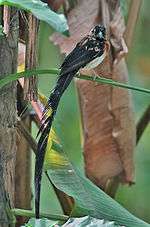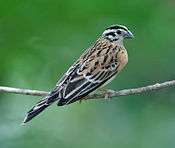Long-tailed paradise whydah
- The name long-tailed paradise whydah can also refer to the exclamatory paradise whydah (Vidua interjecta).
| Long-tailed paradise whydah | |
|---|---|
_(17329851342).jpg) | |
| Scientific classification | |
| Kingdom: | Animalia |
| Phylum: | Chordata |
| Class: | Aves |
| Order: | Passeriformes |
| Family: | Viduidae |
| Genus: | Vidua |
| Species: | V. paradisaea |
| Binomial name | |
| Vidua paradisaea (Linnaeus, 1758) | |
The long-tailed paradise whydah or eastern paradise whydah (Vidua paradisaea) is a small brown sparrow-like bird of Eastern Africa, from eastern South Sudan to southern Angola. During the breeding season the male moults into breeding plumage that consists of a black head and back, rusty brown breast, bright yellow nape, and buffy white abdomen with broad, elongated black tail feathers up to 36 cm long (approximately three times the length of its body). Males and females are almost indistinguishable outside of the breeding season.
It is a brood parasite to the green-winged pytilia. Male long-tailed paradise whydahs imitate the song of the male green-winged pytilia. The whydah chicks are larger and louder than the host chicks, so the foster parents will give them more attention than their own chicks.
Although difficult to breed in captivity because of their brood parasitic nature, these finches, particularly the males, are sold as pets in the United States and other countries. When breeding these birds in captivity, a single male is usually given access to multiple females and each female needs access to multiple active green-winged pytilia nests.
Widespread throughout its large range, the long-tailed paradise whydah is evaluated as Least Concern on the IUCN Red List of Threatened Species.
 Male with breeding plumage |
 Female |
Origin
Origin and phylogeny has been obtained by Antonio Arnaiz-Villena et al.[2] Estrildinae may have originated in India and dispersed thereafter (towards Africa and Pacific Ocean habitats).
References
- ↑ BirdLife International (2012). "Vidua paradisaea". IUCN Red List of Threatened Species. Version 2013.2. International Union for Conservation of Nature. Retrieved 26 November 2013.
- ↑ Arnaiz-Villena, A; Ruiz-del-Valle V; Gomez-Prieto P; Reguera R; Parga-Lozano C; Serrano-Vela I (2009). "Estrildinae Finches (Aves, Passeriformes) from Africa, South Asia and Australia: a Molecular Phylogeographic Study" (PDF). The Open Ornithology Journal. 2: 29–36. doi:10.2174/1874453200902010029.
